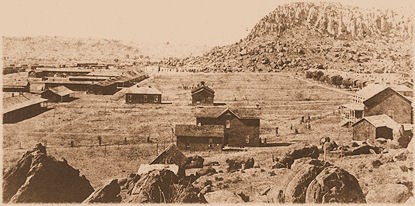
In the mid-1800s, thousands of pioneers, freight wagons, and mail carriers began traveling through the Trans-Pecos region of western Texas - many on their way to the gold fields of California. Because of the presence of Comanches and Apaches, the U. S. Army undertook to build a number of forts to protect their routes of travel. Fort Davis, established in 1854, was one of these posts. This "first" Fort Davis remained active until early in the Civil War, being abandoned in 1862. After the Civil War, travel continued on the San Antonio-El Paso Road and so did raiding by Comanches and Apaches, which resulted in the army re-establishing Fort Davis. In June 1867, Lieutenant Colonel Wesley Merritt arrived with four companies of the Ninth U. S. Cavalry, composed of black soldiers that later became known as Buffalo Soldiers, to rebuild the fort. Over 200 civilians were also hired to help construct the post. The fort was near Limpia Creek, a source of water, and in an area with stone and trees that could be used for building and heating, and where grass was plentiful for the animals. Like most other western frontier army forts, no walls surrounded Fort Davis. The presence of the soldiers was enough to discourage Indian attacks. Although avoiding the fort itself, the Indians persisted in assaulting not only travelers and stage coaches on the road, but mail stations and new settlements. Warriors came from the mountains of New Mexico and the plains of Oklahoma to steal horses, cattle, guns and other goods. They were mobile and good at avoiding the soldiers. From 1867 to 1881, scouting trips into the Guadalupe Mountains and to the Big Bend took up much of the soldiers' time. Their presence gave warning to the Indians that they no longer had a safe hiding place. The army believed that extensive scouting - even if the soldiers did not encounter the Indians - helped lessen the number of attacks. By the late 1870s, Fort Davis troops had also built new roads and had strung 91 miles of telegraph wire to connect the post with other forts. Now the army could communicate long distances by telegraph, and not have to send messengers or use signal flags. During the 1870s, the U. S. Government made a conscious effort to place the Comanches and Apaches who were raiding in western Texas on reservations. Most Indians, however, did not want to live on reservations and some, like the Apache leader Victorio, fled. In order to help track these "runaways" and provide more protection to travelers, the army began setting up sub-post or small camps. In a little over a year, troops from Fort Davis and its sub-posts traveled a total of 6,724 miles on scouting trips. Soldiers from Fort Davis and other forts fought the Apaches in the summer of 1880 and drove them into Mexico. There, Mexican troops killed Victorio and many of his followers in October 1880. Within a few months of Victorio's death, the Indian Wars in Texas came to a close and life at Fort Davis became routine. At any one time, there were from 100 to 400 enlisted men plus officers and families at the fort. The presence of such a large force encouraged the growth of the town adjacent to the post. The fort hired civilians as laborers, clerks, and laundresses. It purchased local supplies such as building materials, hay, fresh beef, wheat, and fresh fruits and vegetables. In 1884, the town of Fort Davis boasted of having a dairy, lumber yard, bakery, furniture store, and several hotels, mercantile stores, and saloons. It was peaceful during the last ten years (1881-1891) the fort was in existence. Soldiers from the fort still patrolled the western frontier, but they were more involved in surveying or repairing roads and telegraph lines. The fort, however, continued to grow. By the late 1880s, it had gas lighting, running water, and an ice machine. It had over one hundred buildings, and its excellent hospital treated people from all around the area - not just people who lived at the fort. The post, nevertheless, was isolated. Located twenty miles from the nearest railroad station, it was built on land the government did not own. Raiding by Comanches or Apaches was over. By June of 1891, the army had judged Fort Davis to have "outlived its usefulness" and ordered it - one of the largest and most prominent frontier military posts in the American Southwest - to be abandoned. |
Last updated: February 24, 2015
